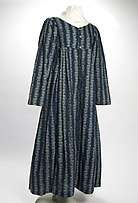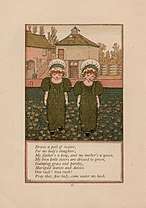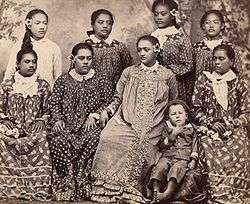Mother Hubbard dress
A Mother Hubbard dress is a long, wide, loose-fitting gown with long sleeves and a high neck. It is intended to cover as much skin as possible. It was devised in Victorian western societies to free women from the constriction of corsets that fashion imposed on better off women. It is mostly known today for its later introduction by Christian missionaries in Polynesia to "civilise" those whom they considered half-naked savages.[1]

Although this Victorian garment has disappeared in most of the world, it is still worn by Pacific women, who have altered it into a brighter and cooler garment, using cotton fabric, often printed in brightly colored floral patterns. It is today seen as smart or formal attire and is often worn to church.[2]
History

In the 1880s the artist Kate Greenaway illustrated popular books of English nursery rhymes showing children in smock dresses. These came to be a popular style of children's dress which were given the name 'Mother Hubbard' by fashion writers at the time after the nursery rhyme character in the books.[1]
Around the same time a dress reform movement arose that sought to free western women from the tight and impracticable clothing of small waists and tight corsets that was dictated by fashion in wealthy society. The smock dress with full length arms proved very adaptable to both size and shape and migrated up the age groups until it became comfortable day wear for women of all ages and across social classes.
Contemporary with this in Victorian times missionary movements attempted to spread what they saw as the benefits of western religion and morals to native peoples under the rule of the imperial western countries. The Mother Hubbard garments were insisted upon by missionaries who were often horrified to find a flock of near-naked people in their churches.[1] They were distributed widely in Africa, South Asia, and the Pacific. They have influenced modern dress in all these areas, but particularly in the Pacific islands where they persist today.
Pacific island dress

Names and designs vary. In Hawaii, it is called holokū.[3] There, a derivative, the muumuu, is highly similar, but without the yoke and train, and therefore even easier to make.[4] In Tahiti, the name was ʻahu tua (empire dress, in a sense of colonial empire); now, ʻahu māmā rūʻau (grandmother's dress) is used. In Samoa and Tonga, the design has taken on a two-piece form, with classic mother hubbard blouses (long, wide, loose-fitting with puffy sleeves) over ankle-length skirts, called "puletasi" and "puletaha," respectively. In Marshallese, the name is wau ([wɑːu]), from the name of the Hawaiian island of Oahu. The missionaries who introduced it in the Marshall Islands came from Oʻahu.[5] In New Caledonia, these dresses are referred to as robes missions (Mission Dresses). New Caledonian women wear these dresses when playing their distinctive style of cricket. In Papua New Guinea, the form of dress is known as meri blaus, which in Tok Pisin means women's blouse. It is considered formal local attire. In the 1960s and 1970s many women in Tarawa, Kiribati and a few i-matang women wore a garment which was referred to as a Mother Hubbard. Whilst the lower half of the body was covered with a wrap-around (lavalava) or a skirt, the top half was worn a very loose low-necked blouse short enough to expose a band of flesh at the waist. The latter was usually worn without underclothes.
Elsewhere
In India and much of South Asia, these dresses are referred to as Housecoats. Indian women wear these dresses as a convenient apparel at home, particularly around only the family members when they are not expecting company.
See also
References
- Gray, Sally Helvenston. "Searching for Mother Hubbard: Function and Fashion in Nineteenth-Century Dress." Winterthur Portfolio48, no. 1 (2014): 29-74. doi:10.1086/676031. https://www.jstor.org/stable/10.1086/676031?read-now=1&refreqid=excelsior%3A0e847f7aac93d99ac0e05631122fad27&seq=2#page_scan_tab_contents
- Cummings, Maggie (2013). "Looking Good: The Cultural Politics of the Island Dress for Young Women in Vanuatu" (PDF). The Contemporary Pacific Vol 25 No 1. University of Hawai'i Press. Retrieved 2018-12-27.
- The Pocket Hawaiian Dictionary with a Concise Hawaiian Grammar by Mary Kawena Pukui, Samuel H. Elbert, and Esther T. Mookini (1975), p 30. ISBN 0-8248-0307-8
- The Pocket Hawaiian Dictionary with a Concise Hawaiian Grammar by Mary Kawena Pukui, Samuel H. Elbert, and Esther T. Mookini (1975), p 111. ISBN 0-8248-0307-8
- Marshallese-English Dictionary: wau